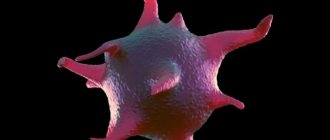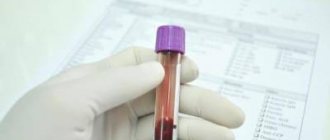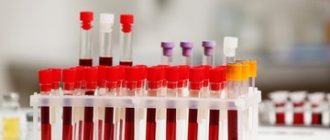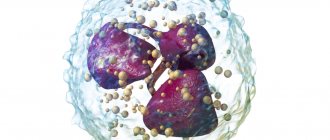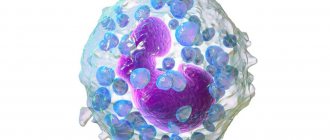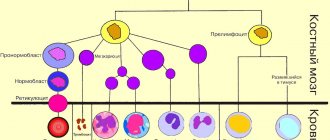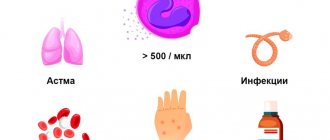CPK (creatine kinase, creatine phosphokinase) in the blood: what it is, reasons for increased enzyme levels.
Among the numerous enzymes contained in human blood, there is one enzyme that is necessary in every cell of the body, and most of all in the cells of nervous tissue and muscles. This element is called creatine kinase or creatine phosphokinase .
KFC: what is it?
Creatine kinase is an enzyme that accelerates the transfer of a phosphoryl residue from adenosine triphosphate (ATP) to creatine. In this case, adenosine diphosphate is formed, and the energy that was previously hidden in the high-energy bonds of ATP is released and used. These complex biochemical processes provide the muscles with the energy they need to contract.
Since muscles contract almost continuously (heart function, intestinal motility, regulation of blood vessel lumens, swallowing, etc.), creatine kinase is continuously used by the body.
Creatine kinase, like other enzymes, is a protein and therefore composed of amino acids. Amino acids enter the body with protein foods, and then the necessary proteins or other amino acids are formed from them.
Loss of muscle mass or lack of dietary protein can affect the amount of creatine kinase in the blood.
Creatine kinase, creatine phosphokinase and isoenzyme fractions
Creatine kinase is an enzyme that participates in the energy metabolism of tissues, acting as a catalyst for important biochemical transformations, in particular, it accelerates the process of phosphorylation of creatine so that the latter can provide the energy basis for muscle contraction.
Most of the enzyme is concentrated in skeletal muscles, heart muscle, smooth muscle fibers of the uterus and nervous tissue of the brain.
The activity of CPK suppresses the thyroid hormone - thyroxine.
The two dimers of creatine kinase (B and M), which make up the enzyme molecule, form combinations (isoenzymes), and although each of the resulting isoenzymes finds a place in different tissues, some are preferred, so the isoenzymes differ in their belonging to one or another organ :
- MM is a muscle isoenzyme, with a predominant localization in skeletal muscles (CK-MM) - its share in the blood plasma accounts for up to 98% of all creatine kinase activity;
- BB - brain isoenzyme, preferential localization is obvious (CC-BB) - is not detected in plasma or serum, since it does not cross the blood-brain barrier (appears in the blood during severe TBI or stroke);
- MB is a hybrid isoenzyme (CK-MB), it prefers the heart muscle, where it is found in large quantities; in serum (plasma) its share is about 2% of the total (total) creatine kinase activity.
Thus, in a laboratory study of the total activity of the enzyme, which we habitually continue to call CPK, we mean the activity of each of the isoenzymes released into the blood from the heart muscle (2%) and skeletal muscle (98%).
Causes of increased creatine kinase
So what causes an increase in the concentration of creatine kinase in the blood? There are a great many such reasons, among them are dystrophies, burns, cancer, and simply intense physical activity. Well, most often the reasons are the following:
- Polymyositis (an autoimmune disease in which cells of the immune system begin to attack muscle tissue, causing damage to almost all muscles);
- Myocardial dystrophy (dystrophy of the heart muscle);
- Myocarditis (inflammation of the heart muscle);
- Oncological diseases (most often at the stage of tumor decay, which is usually accompanied by severe poisoning of the body);
- Convulsions, especially common during epilepsy;
- Overdose of certain drugs (statins, fibrates, amphotericin);
- Alcoholism, alcohol poisoning;
As for muscle overwork, an increase in creatine kinase is observed only in cases where the muscles begin to break down from overwork. This is accompanied by acute pain (sores) associated with the accumulation of metabolic products in muscle tissue.
It happens that creatine kinase also increases after surgery, and the more difficult the postoperative period is, the greater the likelihood of an increase in the concentration of this substance.
Interestingly, constantly elevated levels of creatine kinase can be observed in mentally ill people, namely those suffering from schizophrenia, manic-depressive psychosis , and those who abuse psychotropic drugs.
Features of the analysis
The molecule of creatine phosphokinase is complex. It consists of two dimers: B and M. Certain isoenzymes accumulate in different organs, namely:
- In skeletal muscles - MM.
- In the brain - VV.
- In the heart muscle - CF.
The activity of CK is determined by a set of isoenzymes that enter the blood when the muscle tissue of the skeleton and heart is damaged. Due to the high information content of the study, it can be prescribed by different specialists: cardiologist, oncologist, endocrinologist, neurologist or therapist.
The analysis is a rather complex procedure, therefore, most often, it is carried out in a hospital setting, where there are more equipped laboratories, the equipment of which allows them to provide accurate data. Deciphering the results obtained by a specialist allows you to determine the nature of the violations that have arisen.
A special feature of the study is that it can be used to diagnose myocardial infarction in the first 6 hours of pathology development. 30 hours after a heart attack, CPK levels return to normal.
A multiple increase in the amount of creatine phosphokinase in the blood can occur during heavy physical exertion, muscle injury, or poisoning. In this regard, this biochemical analysis is an important additional tool for confirming or refuting suspicions of the development of a certain pathology.
When is the study ordered?
The purpose of this analysis always has good reasons. Typically this happens in the following cases:
- When there is a need to diagnose the development of myocardial infarction at the initial stages and it is necessary to monitor its dynamics.
- If it is necessary to clarify the diagnosis for serious diseases of the skeletal muscles.
- After serious injury to muscle tissue, in order to determine the extent of the damage.
- If you suspect cancer or are undergoing treatment for tumors.
The analysis is necessarily indicated for patients who are being treated in a cardiology hospital. This allows you to monitor the condition of the heart muscle and, if necessary, adjust the treatment measures.
The study is aimed at detecting an increase in the amount of creatine phosphokinase in the blood. If there is a certain tendency towards an increase in indicators, then it is quite possible to talk about an existing threat to the heart muscle.
Reasons for the downgrade
Of course, in certain situations, creatinine kinase can drop sharply. This happens in the main period when a person’s muscle mass decreases. Any fluctuations in muscle mass can be a consequence of natural processes, as well as the results of various diseases. Typically, muscle mass decreases with age, a phenomenon called sarcopenia . A painful decrease in muscle mass is observed, for example, with prolonged fasting, lack of protein food, and infectious lesions of muscle tissue.
Also, a decrease in creatine kinase can be observed with alcoholic liver damage and liver cirrhosis. of ascorbic acid, aspirin, and amicocin also leads to similar results . Pregnant women also experience a slight decrease in the concentration of creatine kinase, which is quickly replenished after childbirth.
Neither an increase nor a decrease in creatine kinase is not a specific sign by which one can judge the presence of any disease in the body.
We see that there are a large number of diseases associated with fluctuations in the concentration of this enzyme, so before drawing conclusions about the patient’s health, additional examination should be carried out.
And many more diseases...
In addition to myocardial infarction, for which creatine phosphokinase is an early marker of damage to the heart muscle (increases 10–30 times in the first hours and reaches a maximum after 20–30 hours), an increase in enzyme activity is observed in a number of other pathological conditions:
- All types of muscular dystrophies;
- Polymyositis, viral myositis;
- Traumatic damage to the muscular system (long-term compression syndrome or crash syndrome);
- Extensive surgical operations (postoperative period);
- A state of skeletal muscle hypermetabolism called malignant hyperthermia (acute fulminant state). This pathology develops during general anesthesia for surgery and can pose a threat to the patient’s life;
- Traumatic brain injuries, brain contusion;
- Vascular pathology of the brain;
- Stroke (cerebrovascular ischemia);
- Rheumatic carditis;
- Rhythm disturbances in heart failure (congestive);
- PE (increased creatine kinase activity is observed relatively rarely);
- Damage to the heart muscle due to hypoxia (shock, hyperthermia);
- Significant load on the muscular system (running, strength sports, professional activities);
- Injections of certain medications into the muscle (narcotics, non-narcotic analgesics, certain antibiotics, sedatives and psychotropics);
- Raynaud's phenomenon;
- Strychnine poisoning;
- Impaired blood circulation and trophism, leading to the development of necrosis (bedsores) - problems for weakened bedridden patients;
- Skeletal muscle spasms;
- Acute alcohol intoxication;
- Mental pathology (epilepsy, manic-depressive syndrome, schizophrenia);
- Exposure to radioactive radiation with the development of acute radiation sickness;
- Pathology of the thyroid gland with a decrease in its function (hypothyroidism);
- Malignant neoplasms localized in the uterus, intestines, bladder and other organs.
Creatine kinase does not increase during angina pectoris and this enzyme practically does not react to the suffering of the liver and lungs, even if the cells of these organs, for some reason other than malignant tumors, begin to rapidly deteriorate.
CPK levels in women
There are a number of features of the female body associated with the metabolism of creatine kinase. Firstly, due to the fact that women have less developed skeletal muscles, the concentration of this enzyme in their blood is noticeably lower than in men.
Secondly, the amount of creatine kinase may decrease slightly , while the amount of this enzyme in the placenta and placental blood, on the contrary, is higher than in the rest of the human bloodstream. This affects the amount of blood enzyme in a newborn baby, which is also higher.
Thirdly, the gene for congenital muscular dystrophy is often detected in young women. This is a rare genetic disease, the gene for which is located on the X chromosome, as well as the gene responsible for hemophilia. Just like hemophilia, muscular dystrophy most often affects boys. A woman who carries the gene has a 100% chance of having a son with the disease .
Creatine phosphokinase
In the structure of creatine kinase there are 2 subunits: M - muscle (muscle) and B - brain (brain). In this regard, three isoforms of this enzyme are distinguished:
- CPK-MM - found mainly in skeletal muscles;
- CPK-MB – localized in the myocardium;
- CPK-BB is an enzyme of nervous tissue.
Total creatine phosphokinase and its isomers can be determined in the blood.
Consequently, when a certain type of tissue is damaged, an increase in the activity of the corresponding isoform of creatine phosphokinase is characteristic. What increases and under what diseases will be discussed below.
Changes in the body during pregnancy
During pregnancy, the level of creatine kinase decreases slightly, which has virtually no effect on the mother’s well-being or her health in the future. This decrease is associated not only with bearing a child, but with the fact that the lifestyle of the expectant mother changes, or physical activity decreases significantly, especially in the later stages.
At the same time, the fetus's creatine kinase levels are elevated. For comparison: if an adult woman has 167 units of creatine kinase per liter in her blood, then a fetus in late pregnancy has 650 or more .
And many more diseases...
In addition to myocardial infarction, for which creatine phosphokinase is an early marker of damage to the heart muscle (increases 10–30 times in the first hours and reaches a maximum after 20–30 hours), an increase in enzyme activity is observed in a number of other pathological conditions:
- All types of muscular dystrophies;
- Polymyositis, viral myositis;
- Traumatic damage to the muscular system (long-term compression syndrome or crash syndrome);
- Extensive surgical operations (postoperative period);
- A state of skeletal muscle hypermetabolism called malignant hyperthermia (acute fulminant state). This pathology develops during general anesthesia for surgery and can pose a threat to the patient’s life;
- Traumatic brain injuries, brain contusion;
- Vascular pathology of the brain;
- Stroke (cerebrovascular ischemia);
- Rheumatic carditis;
- Rhythm disturbances in heart failure (congestive);
- PE (increased creatine kinase activity is observed relatively rarely);
- Damage to the heart muscle due to hypoxia (shock, hyperthermia);
- Significant load on the muscular system (running, strength sports, professional activities);
- Injections of certain medications into the muscle (narcotics, non-narcotic analgesics, certain antibiotics, sedatives and psychotropics);
- Raynaud's phenomenon;
- Strychnine poisoning;
- Impaired blood circulation and trophism, leading to the development of necrosis (bedsores) - problems for weakened bedridden patients;
- Skeletal muscle spasms;
- Acute alcohol intoxication;
- Mental pathology (epilepsy, manic-depressive syndrome, schizophrenia);
- Exposure to radioactive radiation with the development of acute radiation sickness;
- Pathology of the thyroid gland with a decrease in its function (hypothyroidism);
- Malignant neoplasms localized in the uterus, intestines, bladder and other organs.
Creatine kinase does not increase during angina pectoris and this enzyme practically does not react to the suffering of the liver and lungs, even if the cells of these organs, for some reason other than malignant tumors, begin to rapidly deteriorate.
Enzyme content in children
In children, the level of creatine kinase in the blood is very high, especially in the first days of life. So, for the first 5 days, the level of creatine kinase remains the same as that of the fetus before birth, that is, about 650 units per liter of blood. However, over the next 6 months, the amount of enzyme decreases by 2-2.5 times.
Until the age of one year, the amount of creatine kinase continues to fall; at the age of about one year it is about 200 units per liter. Then, due to the child's increasing activity, the amount of creatine kinase increases again. In time, this coincides with teaching a child to walk, run, manipulate objects, and so on.
But, if by the age of three the amount of creatine kinase reaches 220 units , then it begins to fall again, and by the age of six it is already 149 units.
From the age of 9-10 years, a child begins puberty, and the concentration of blood enzymes in girls and boys begins to differ.
The reasons for deviations from the norm in children are the same as in adults, with the exception, of course, of pregnancy. It should be borne in mind that children are more likely than adults to be overtired, and also often experience a lack of protein due to poor nutrition.
References
- Clinical guidelines for the diagnosis and treatment of myocarditis, 2019. - 133 p.
- Acute myocardial infarction with ST segment elevation of the electrocardiogram. Clinical guidelines, 2021. - 157 p.
- Mucocutaneous lymphonodular syndrome [Kawasaki] (Kawasaki syndrome/disease) in children. Clinical guidelines, 2021. - 41 p.
- Aydin, S., Ugur, K., Aydin, S. et al. Biomarkers in acute myocardial infarction: current perspectives. Vasc Health Risk Manag, 2021. - Vol. 15. - P. 1-10.
- Cao, F., Zervou, S., Craig, A. et al. The creatine kinase system as a therapeutic target for myocardial ischaemia–reperfusion injury. Biochem Soc Trans, 2021. - Vol. 46(5). — P. 1119-1127.
What are the dangers of deviation from the norm?
Creatine kinase itself is not a toxic substance, so an excess does not pose any threat to the human body.
Serious threats to it are those diseases that caused an excess of this enzyme, for example, cancer, heart attacks, inflammatory processes in the muscles, various poisonings, and so on.
A lack of creatine kinase can affect the functioning of muscles and the nervous system . It causes muscle weakness, fatigue, dizziness, problems with attention and the ability to perform physical work.
Creatine kinase, creatine phosphokinase and isoenzyme fractions
Creatine kinase is an enzyme that participates in the energy metabolism of tissues, acting as a catalyst for important biochemical transformations, in particular, it accelerates the process of phosphorylation of creatine so that the latter can provide the energy basis for muscle contraction.
Most of the enzyme is concentrated in skeletal muscles, heart muscle, smooth muscle fibers of the uterus and nervous tissue of the brain.
The activity of CPK suppresses the thyroid hormone - thyroxine.
The two dimers of creatine kinase (B and M), which make up the enzyme molecule, form combinations (isoenzymes), and although each of the resulting isoenzymes finds a place in different tissues, some are preferred, so the isoenzymes differ in their belonging to one or another organ :
- MM is a muscle isoenzyme, with a predominant localization in skeletal muscles (CK-MM) - its share in the blood plasma accounts for up to 98% of all creatine kinase activity;
- BB - brain isoenzyme, preferential localization is obvious (CC-BB) - is not detected in plasma or serum, since it does not cross the blood-brain barrier (appears in the blood during severe TBI or stroke);
- MB is a hybrid isoenzyme (CK-MB), it prefers the heart muscle, where it is found in large quantities; in serum (plasma) its share is about 2% of the total (total) creatine kinase activity.
Thus, in a laboratory study of the total activity of the enzyme, which we habitually continue to call CPK, we mean the activity of each of the isoenzymes released into the blood from the heart muscle (2%) and skeletal muscle (98%).
Preparing for the study
In order to find out what the concentration of creatine kinase is in your blood, you can go to a regular hospital. The concentration of creatine kinase is determined during a routine biochemical blood test. One day is enough to receive test results. Such an analysis costs about 370 rubles. To carry it out, blood is taken from a vein. Referrals for analysis can be obtained from a general practitioner, oncologist, cardiologist, and other specialists.
You should prepare for that crowd the same way as any other: the analysis is done in the morning on an empty stomach , 8 hours after the last meal. It is advisable not to smoke, drink, or take medications 3 days before the test. Since the amount of enzyme directly depends on physical activity, you should also not engage in sports or heavy physical labor.
Features of therapeutic effects
Restoring enzyme levels requires therapeutic measures that will depend on the specific disease. In addition, there are basic principles that must be observed:
- If CK in the blood is increased, which indicates changes in the functioning of the myocardium, the doctor prescribes complete physical rest. Sports and simply excessive activity are contraindicated.
- Careful menu planning. It should contain dishes that reduce the amount of lipids in the body. Eating garlic and citrus fruits is beneficial. Green tea helps reduce CPK levels.
- Rejection of bad habits. This will allow you to regain lost health and restore immunity.
A person learns about what creatine phosphokinase is when the corresponding diseases develop. Blood and changes in its parameters are the main indicator, based on the study of which a diagnosis is made. Pathologies of the heart require mandatory consultation with a doctor and serious examinations. Cases where a high level of the enzyme is detected indicate the presence of serious disturbances in the functioning of organs. Timely medical care will help avoid complications and restore your previous quality of life.
